The world's 28 tastiest sausages, ranked
The most delicious sausages from around the world

Natalia Kaiser/Shutterstock
Sausages are among the most universal foods there is, with delicious sausage styles and dishes found around the world.
Fresh, cured or fermented, grilled, fried, braised or barbecued, we round up the best sausages from around the globe – from the familiar to the lesser-known styles that every food lover should try.
We've based our ranking on the enduring popularity of each sausage in its place of origin and beyond, and on the opinions of our well-travelled (and well-fed) team. The list is unavoidably subjective.
28. Andouille, France
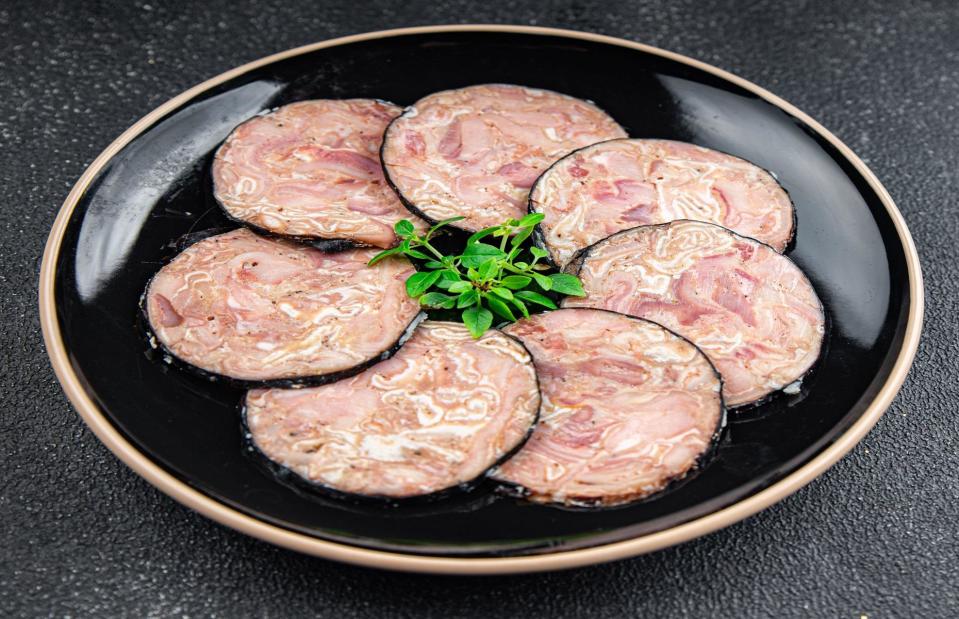
Alesia Bierliezova/shutterstock
Andouille is a large smoked sausage from France made with pork chitterlings, tripe, onion and wine. Originating in the Middle Ages, Andouille is popular in Brittany and Normandy, where it's usually steamed, then served cold and sliced. With a strong, almost pungent aroma, and a taste compared to a barnyard, it's something of an acquired taste. Andouille should not be confused with the smaller and unsmoked andouillette, which is made from the large intestine and stomach of a pig; the most famous variety is the andouillette de Troyes from the Champagne-Ardenne region, often served hot from the grill.
27. Glamorgan sausage, Wales
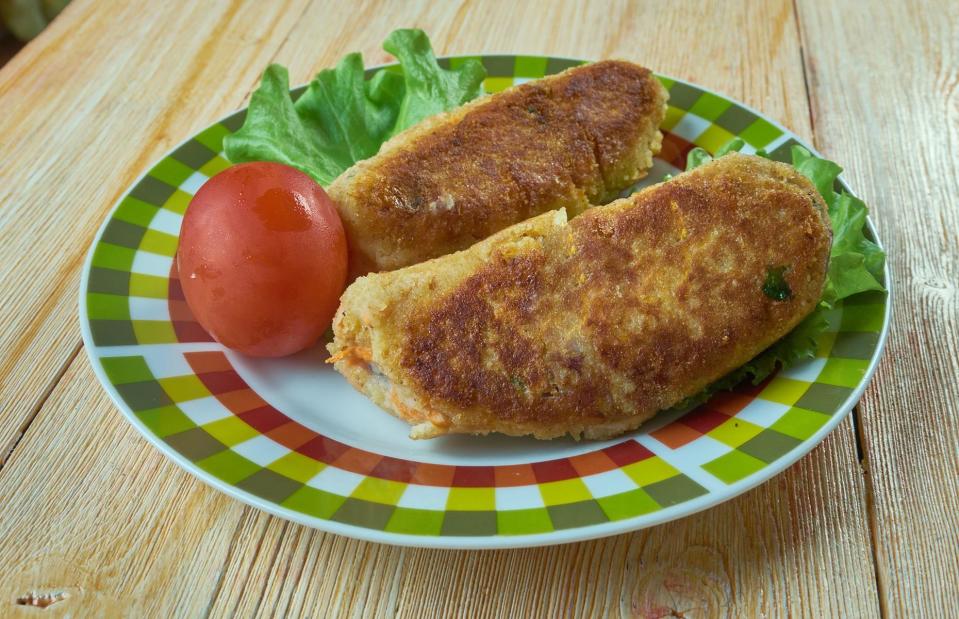
Fanfo/Shutterstock
Unusually, this Welsh sausage contains no meat. Named after the Welsh county of Glamorgan, it's made from cheese (usually Caerphilly, a crumbly white cheese from the Welsh town of the same name), leeks or onions and breadcrumbs. Dating back to the mid-19th century, the sausages became popular during the Second World War, when rationing meant meat was scarce. The sausage has a mild, cheesy flavour and soft texture inside, contrasted with a crips breadcrumb coating, and is typically served as a starter, with pickles, or a main course with mashed potatoes.
26. Saveloy, UK
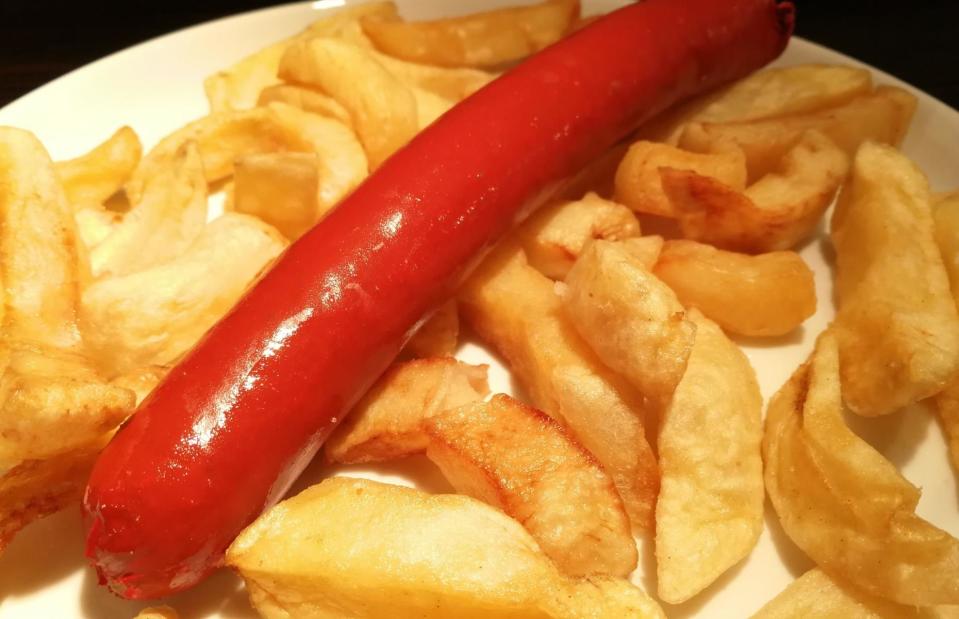
BillyDoogs/Shutterstock
You're most likely to find this bright red smoked sausage at a traditional British fish and chip shop. Traditionally made with pork brains, modern versions of the saveloy now feature finely ground and emulsified pork flavoured with herbs and spices like mace, paprika, cayenne, white pepper and sage. A beef collagen casing provides a snap and bite in contrast with the smooth, highly flavoured filling. Saveloys are boiled or battered, deep fried and served with chips.
25. Falukorv, Sweden
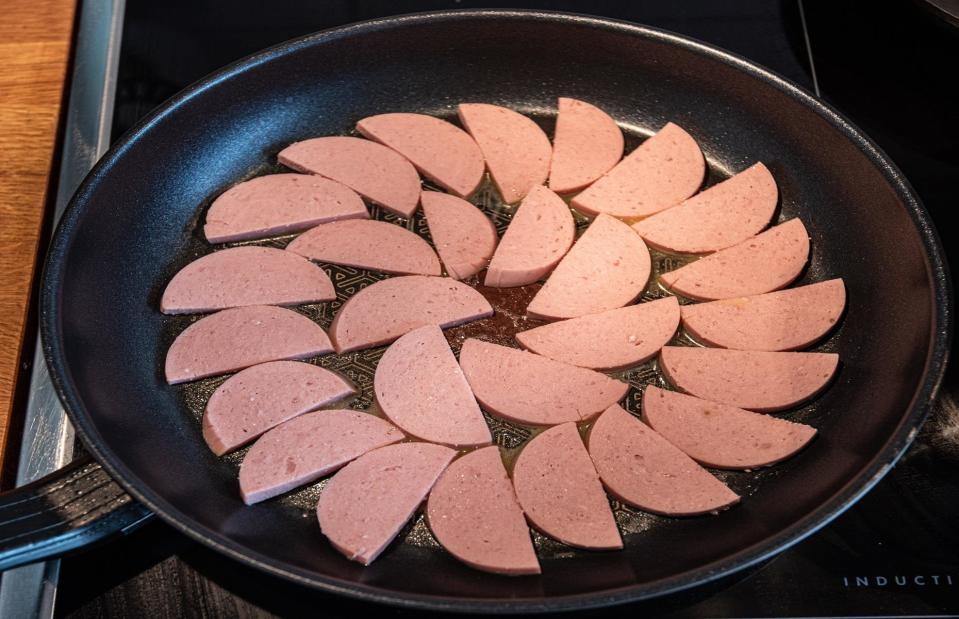
Trygve Finkelsen/Shutterstock
Originating in the central Swedish city of Falun in the 16th century, Falukorv is a large, mildly spiced sausage made with grated smoked pork and beef or veal, then smoked before being cooked in a red plastic casing. The flavour is sometimes described as somewhere between a hot dog and Spam. This inexpensive sausage is often eaten in Swedish homes, either pan-fried in slices and served with creamed macaroni or baked in the oven to be devoured with mashed potatoes.
24. Sujuk, Turkey
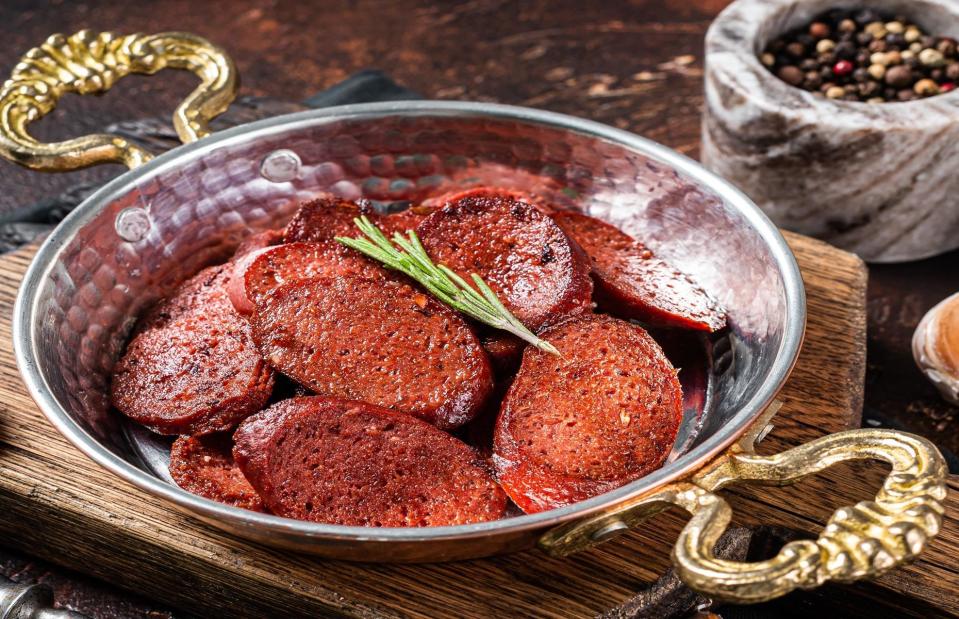
Mironov Vladimir/Shutterstock
This dry cured, spicy, ground beef sausage is a national dish of Turkey. The sausage, whose name is sometimes spelt sucuk, is seasoned with a mix of spices that can include cayenne pepper, garlic, cumin and sumac. Firm in texture and with high-fat content, the sausage is often pan-fried and served as part of a kahvaltı (Turkish breakfast) with cheese, olives, bread and honey. Variations of sujuk, made with beef or lamb, can be found in Balkan, Middle Eastern and Central Asian cuisine.
23. Goa sausage, India
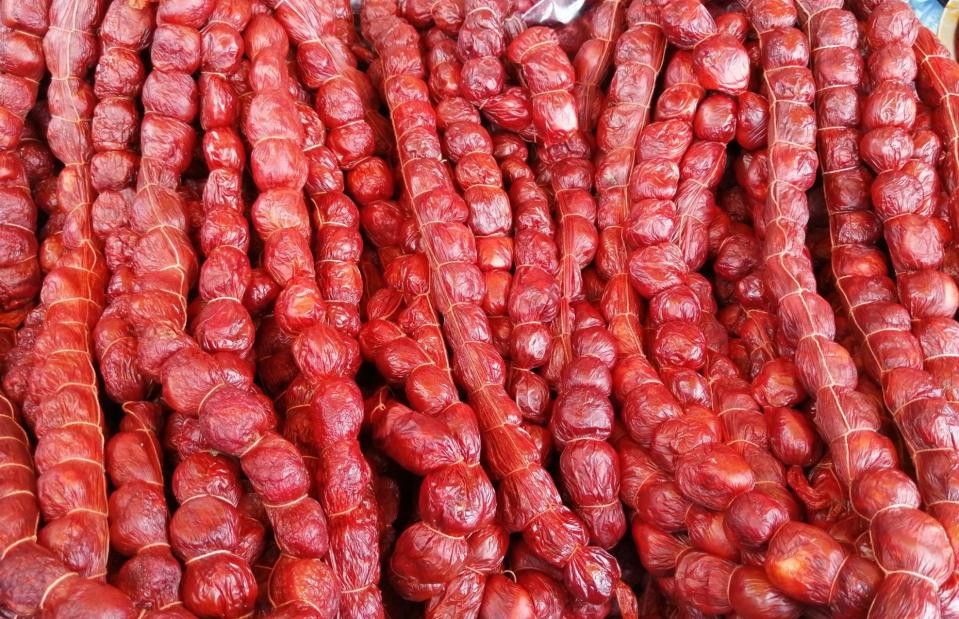
Rachael Pinto/Shutterstock
Related to Spanish chorizo, the hot and spicy pork Goa sausage, from the west coast of India, gets its distinctively tangy flavour from the addition of todd, or coconut, vinegar. Also known as choris, Goa sausages are made with a mix of fatty pork chunks flavoured with chilli, spices and vinegar that’s traditionally stuffed into pig, goat or cow gut. The sausages, which can be long or made into stubby ‘rosary’ sausages (so-called because they look like rosary beads), are smoked, sun-dried and served in a chilli fry with onions and potatoes.
22. Longaniza, Argentina
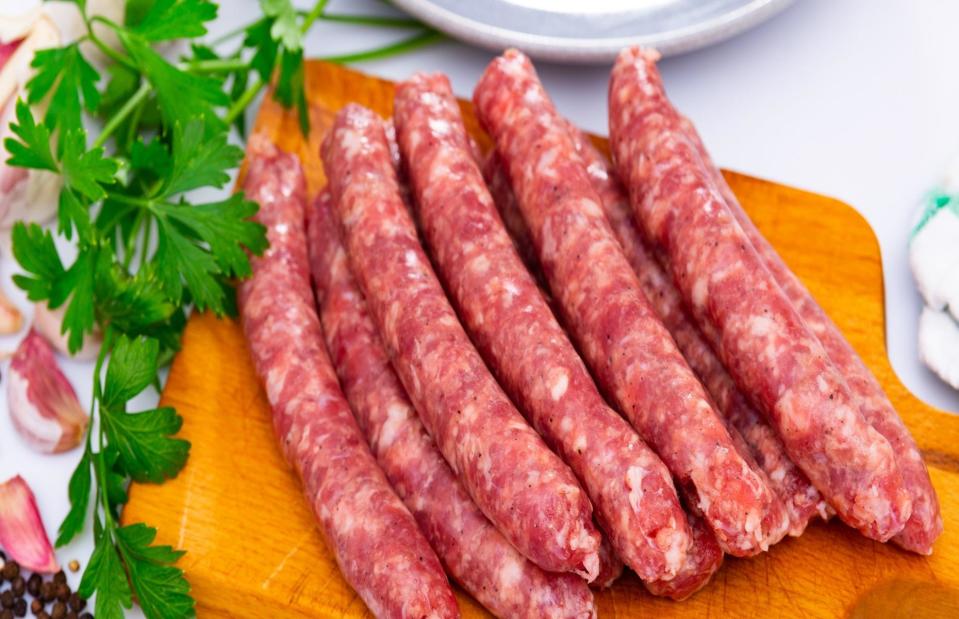
BearFotos/Shutterstock
This cured and dried red pork sausage, typically eaten as an appetiser or in a sandwich, is flavoured with ground anise seeds, which lend it a distinctive sweet herbal aroma and flavour to balance the highly seasoned ground pork shoulder filling. Other ingredients can include a percentage of beef in the mix (for added depth of flavour), garlic, wine or vinegar, and spices including allspice, nutmeg and paprika. Variations of longaniza can be found in world cuisines including those of Chile, Mexico, Peru, Spain and Uruguay.
21. Sai ua, Thailand
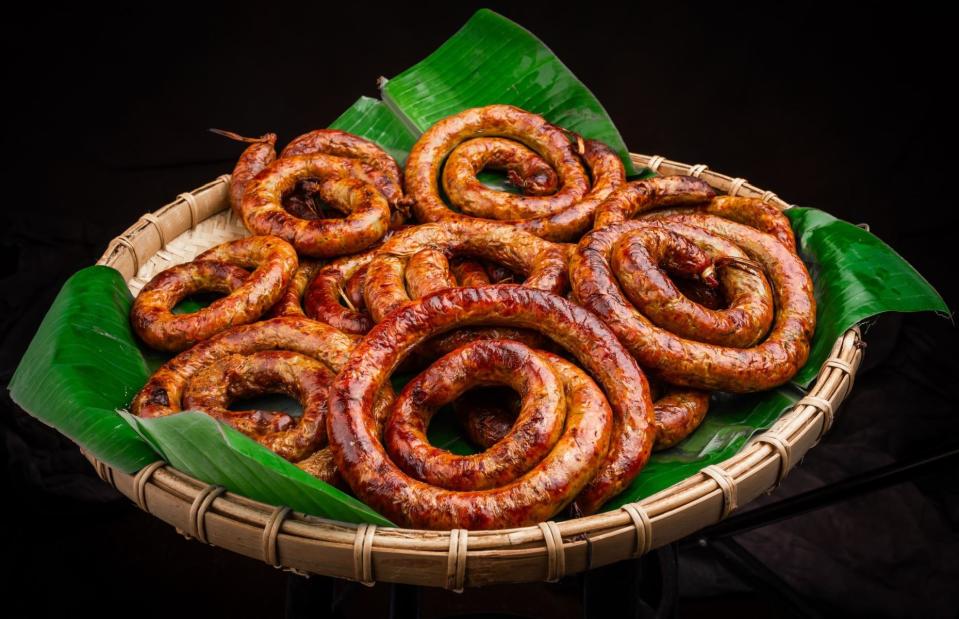
kc.bangkaew/Shutterstock
Originating in the north, this spicy pork sausage is now popular all over Thailand. Fatty minced pork is boldly flavoured with red Thai curry paste and other seasonings, which may include makrut lime and coriander, before being stuffed into natural casings. Sai ua is served grilled with sticky rice, either as part of a larger meal or as a snack or starter.
20. Cervelat, Switzerland
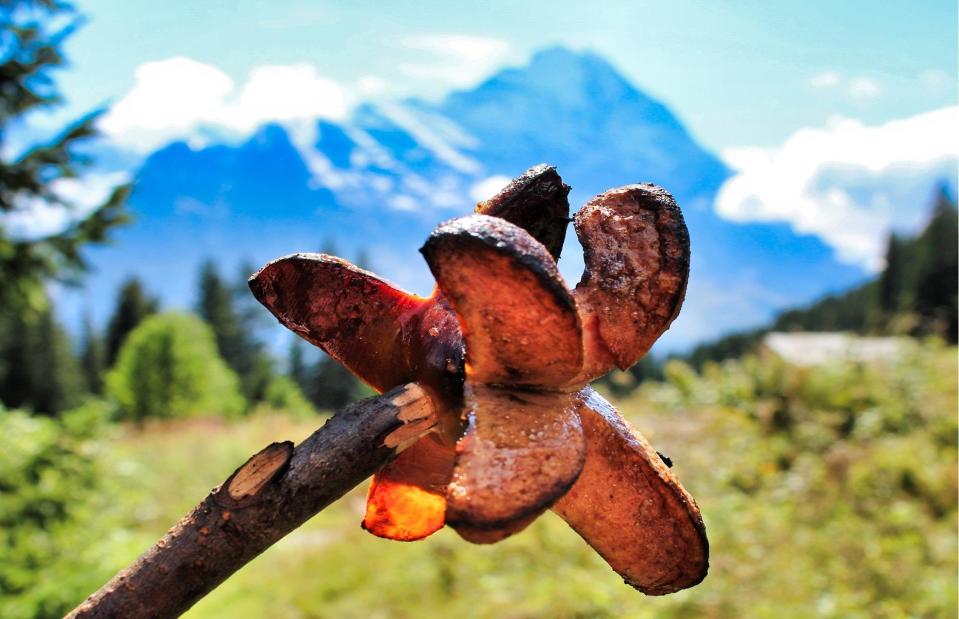
Michaela Leona/Shutterstock
Often called the national sausage of Switzerland, cervelat is a fine-textured mix of beef, pork and bacon, and can be flavoured with onion, garlic, nutmeg and coriander. Sold lightly smoked and boiled, cervelat can be served cold, chopped into a Wurst-Käse salat with Gruyère or, more often, cut crosswise at each end and cooked on a stick over an open fire, as pictured.
19. Morteau, France
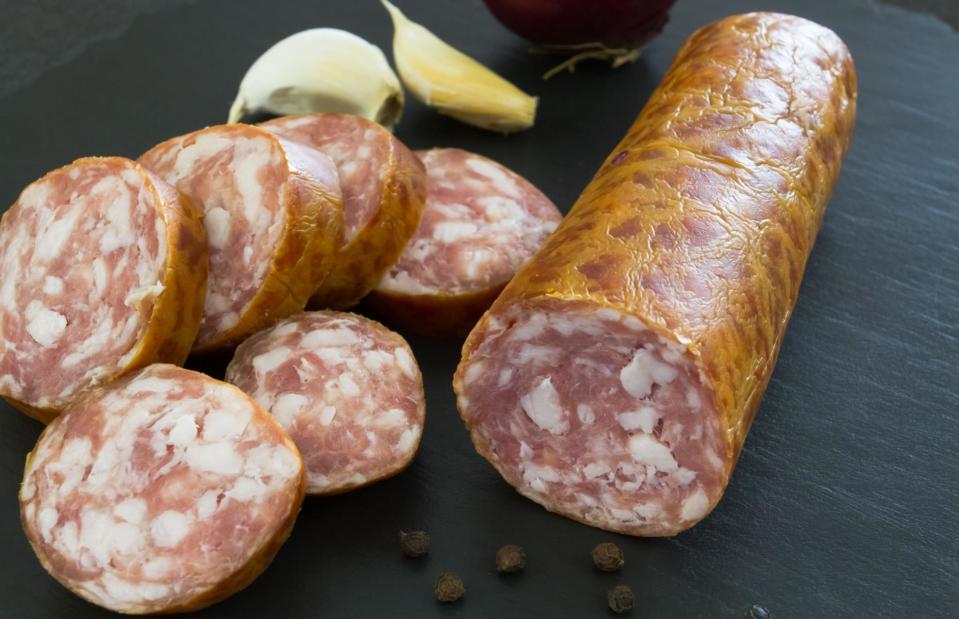
page frederique/shutterstock
Morteau is a French smoked sausage from the Franche-Comté region. Named after the city of Morteau, the sausage is traditionally made with the shoulder and belly of the Le porc de Franche-Comté breed of pig, with the meat smoked for 48 hours over conifer and juniper in pyramid-shaped chimneys called tuyés. Fatty, firm textured and strongly flavoured, Morteau is often served alongside potatoes or pulses in classic French dishes including cassoulet, sauerkraut à l'Alsacienne and petit sale aux lentilles.
18. Botifarra, Spain
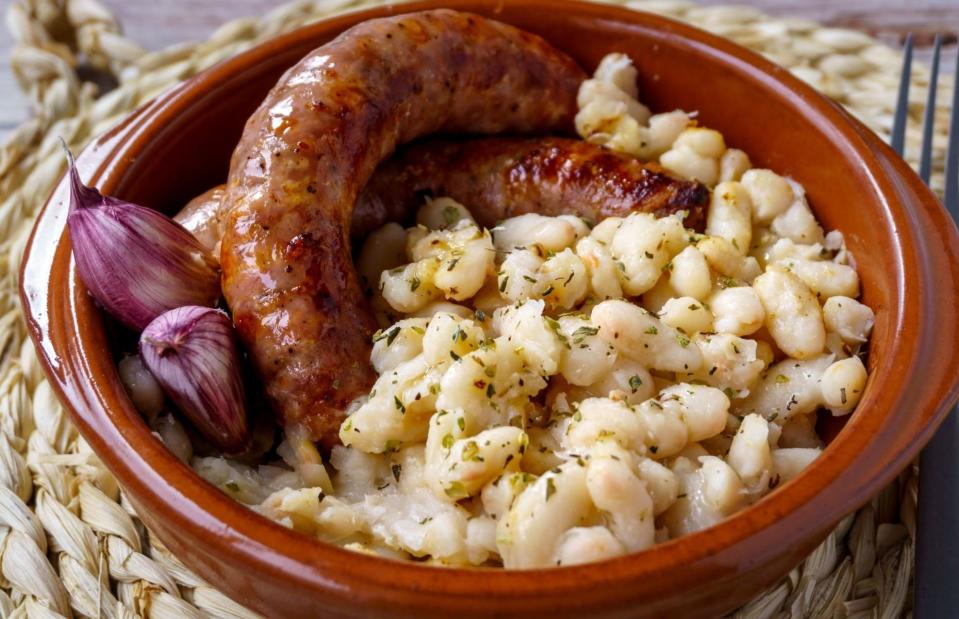
Manuel Milan/Shutterstock
This simple fresh sausage of raw pork and spices is thought to be based on the ancient Roman recipe of botulu, and is a staple of Catalan cooking. In its simplest form, it’s flavoured with only salt and pepper. But variations on botifarra (also known as butifarra) include botifarra d’ou (with egg), botifarra d’arròs (with rice) and botifarra bisbe (with blood and tripe).
17. Boudin blanc, France
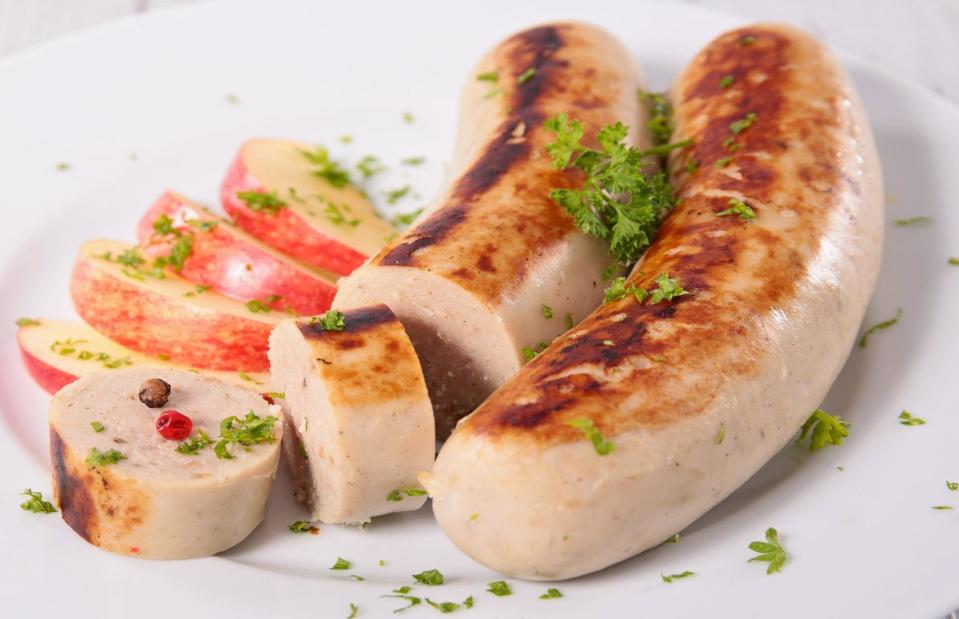
margouillat photo/Shutterstock
This pale poached sausage can be made with finely minced veal, chicken or pork. It's traditionally eaten hot with apples. Boudin blanc de Rethel, from the Ardennes department in northern France, was awarded protected status in 2001. Made from 75% lean pork and 25% fat, the sausage has a particularly light texture due to stiffly beaten egg whites, which are folded into a filling that also includes egg yolks, milk, shallots softened in butter, white pepper and nutmeg.
16. Boerewors, South Africa
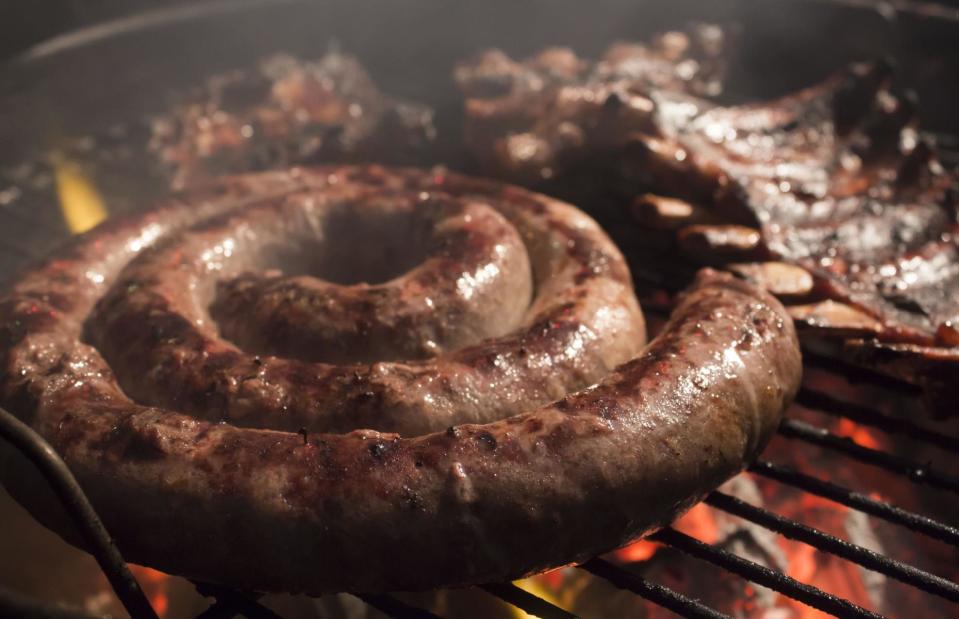
Riaan Coetzee/Shutterstock
Popular across Southern Africa, boerewors (farmer’s sausage) is a fresh sausage made from coarsely minced beef, pork, lamb or goat and flavoured with a spice mix that can include coriander seed, black pepper, nutmeg, cloves and allspice. The sausage is sometimes also made with the meat of springbok or oryx antelopes. It's traditionally cooked on a braai (a South African barbecue) and served with pap, a maize meal porridge.
15. Toulouse, France

Jerome.Romme/Shutterstock
This coarsely minced pork sausage from the south of France is made with fatty shoulder and belly simply flavoured with black pepper and nutmeg, and is a key ingredient in cassoulet. Like Cumberland sausage from Britain, Toulouse sausage is sold in coiled lengths and can be grilled, fried or baked. It also adds mild spice and texture to French soups and stews such as garbure, which is made with confit duck, ham hocks, white beans and vegetables.
14. Chipolata, UK
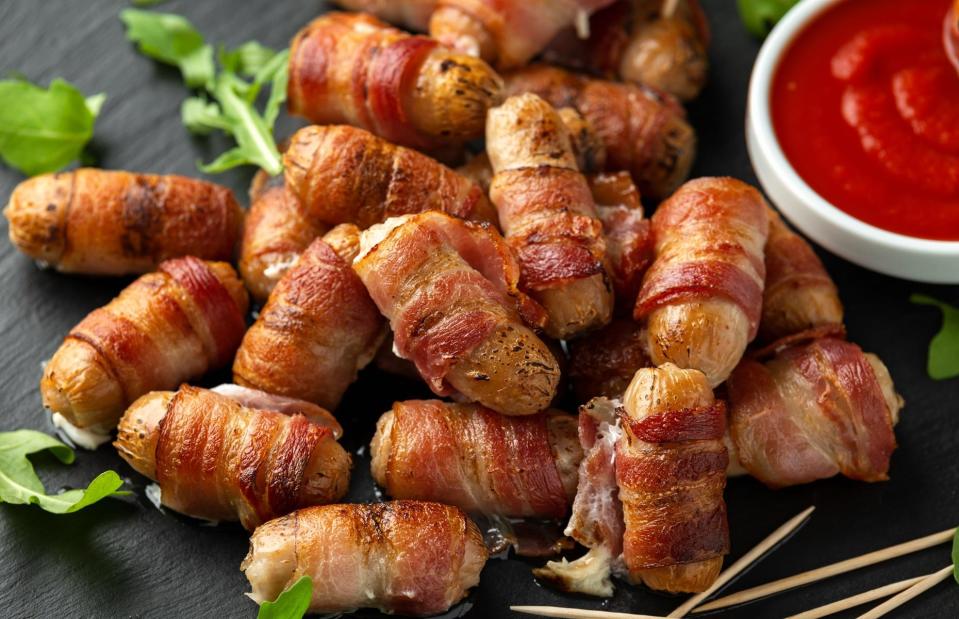
DronG/Shutterstock
Chipolatas, small thin fresh sausages made with coarsely ground pork, are synonymous with a traditional British Christmas dinner, where they’re wrapped in bacon to make pigs in blankets. However, they get their name from cipolla, the Italian word for onion – despite a distinct lack of onion in these sausages. The term was originally used to describe a stew of onions and small sausages while, in French cuisine, a la chipolata is a mixture of chestnuts, pearl onions, carrots, mushrooms, bacon and fried chipolatas in a Madeira sauce.
13. Cotechino, Italy
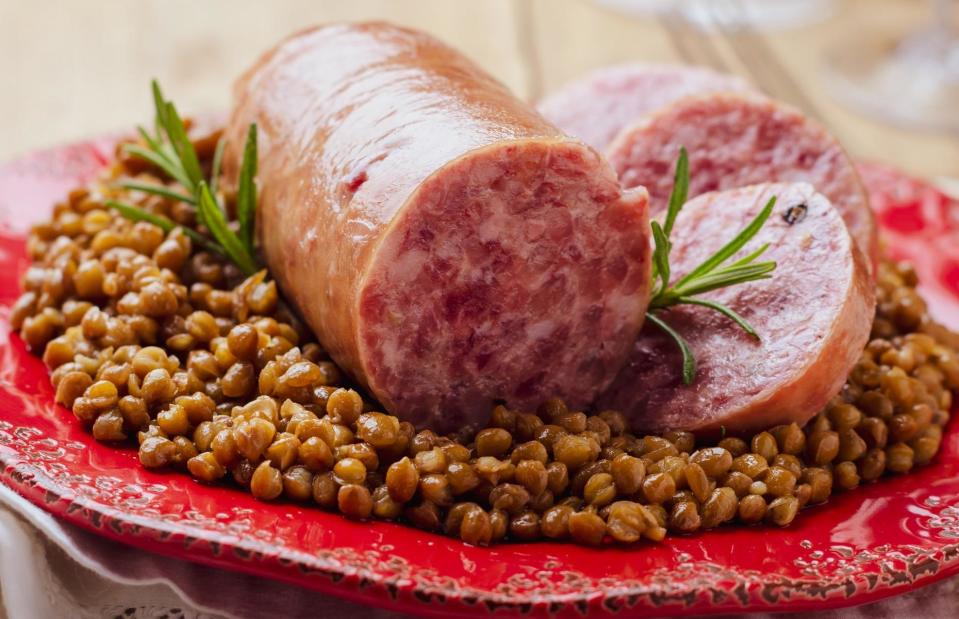
Olga Larionova/Shutterstock
This large pork sausage, associated with the regions of Emilia-Romagna, Lombardy and Piedmont, gets its richness from an equal quantity of finely ground rind and fat-to-lean meat. The filling is flavoured with a mix of spices and herbs including coriander, allspice, ginger, cinnamon and pepper. The cotechino, which requires long, slow cooking, is most famously served as part of a bollito misto, a dish of boiled meats that traditionally includes beef, veal, chicken, tongue and calf’s head.
12. Kabanos, Poland

zi3000/Shutterstock
This distinctively long and thin smoked pork sausage, folded in the middle, has been made in Poland since the Middle Ages. Chilli and black pepper lend a piquant flavour, while the sausage can be soft or dry and hard depending on the duration of smoking and hot or mild depending on the level of spicing. Kabanos is most commonly served sliced as a snack, but can also be used as a pizza topping, in salads or in pasta sauces.
11. Black pudding, UK
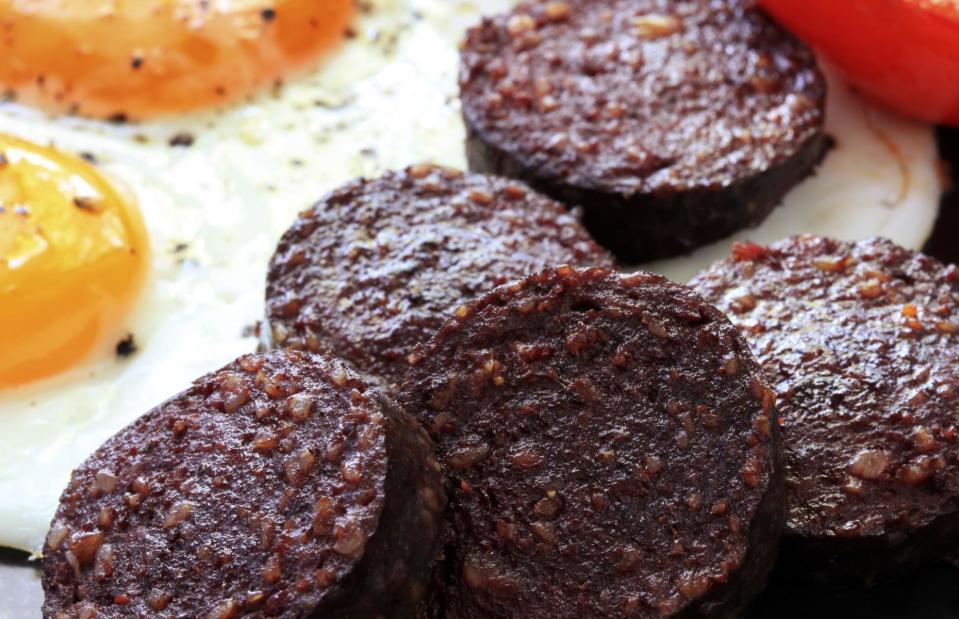
Robyn Mackenzie/Shutterstock
British black pudding is made from fresh or dried pigs' blood mixed with back fat, onions, oatmeal and seasonings, which is used to fill the casing and simmered in water until cooked. It's mostly associated with the Midlands and the North of England, while one of the most famous regional variations is the horseshoe-shaped Bury black pudding, dating back to the early 19th century. With a rich, earthy flavour and crumbly texture, black pudding is often served as part of a full English breakfast, and is a close relation to French boudin noir and Spanish morcilla.
10. Pepperoni, USA

Nail Bikbaev/Shutterstock
This spiced, cured, smoked and air-dried sausage is easily recognisable thanks to its bright red hue, fine texture and smoky flavour. Although it borrows its name from pepperoni, the Italian word for bell peppers, it's thought to be an Italian American creation dating back to the early 20th century. Flavourings can include paprika, chilli and fennel. It's most often served as a pizza topping, of course, but can be added to salads, sandwiches and pasta dishes, lending a piquant, peppery flavour thanks to ingredients like paprika, chilli and fennel. The biggest-selling pepperoni brand in the US is Hormel, which makes it with pork and beef flavoured with paprika and garlic.
9. Mortadella, Italy

bogumil/Shutterstock
This large, soft textured, steamed – and very pink – pork sausage originates in 14th-century Bologna, Emilia-Romagna. It's threaded with strips of salted pork fat, which produce a mosaic effect when the sausage is sliced. Mortadella can also contain peppercorns, pistachios or olives, and is typically served as finger food, and is also an ingredient in tortellini alla Bolognese. Bologna sausage, or baloney, is the US equivalent of mortadella, though it doesn't contain visible pieces of fat due to US government regulations.
8. Cumberland, UK
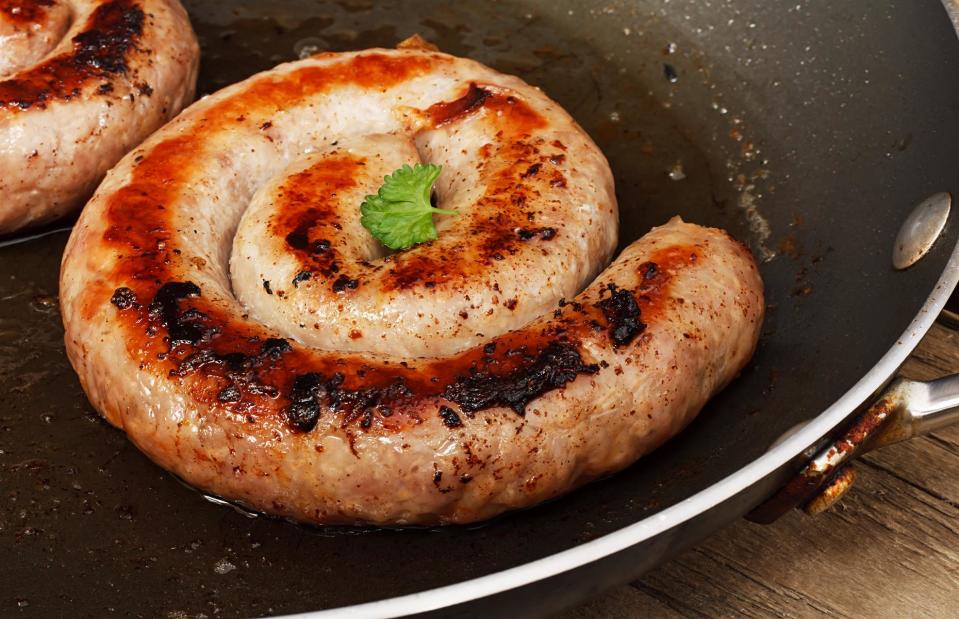
stocksolutions/Shutterstock
This traditional British pork sausage originates in the historic county of Cumberland, in northwest England around 500 years ago. Its Catherine wheel–like spiral shape makes it instantly recognisable, while the coarse texture is equally distinctive, flavoured with white pepper, salt and small amounts of cayenne and nutmeg. The grilled, baked or pan-fried sausages are traditionally served with mashed potatoes and apple sauce. Ninth-generation butcher's shop RD Woodall in Waberthwaite, Cumbria claims to be ‘The Home of Cumberland Sausage’, with a recipe it claims dates back centuries.
7. Merguez, North Africa

page frederique/Shutterstock
This spicy, fresh lamb or beef sausage is a mainstay of the cuisine of the Maghreb region of northwest Africa, including Morocco and Tunisia, where it's often served, sizzling from the grill, as a street food. Merguez sausages get their complex, deep flavours and characteristic red colour from a mix of harissa and cumin, while other flavourings might include garlic and fennel seed. They're usually grilled, and sometimes served with couscous.
6. Lap cheong, China
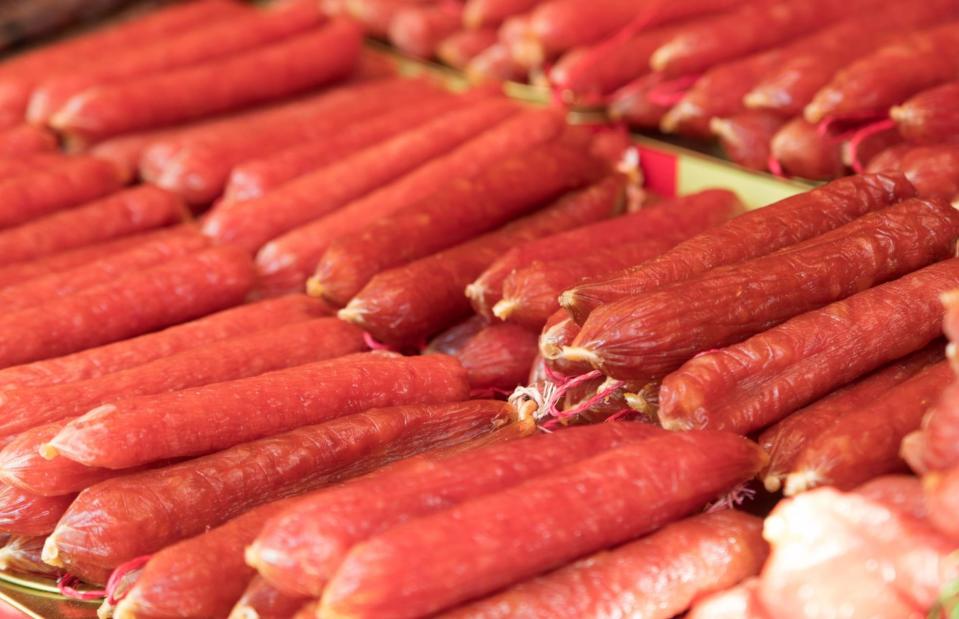
Tang Yan Song/Shutterstock
Lap cheong is a dried hard pork sausage from southern China that’s preserved with sugar and wine. Resembling a thin salami, it's dark red with flecks of fat, and the flavour leans more towards sweet than spicy. A versatile ingredient, it appears in stir-fries, rice and chicken dishes, among others. If ‘Chinese sausage’ appears listed in a recipe, it's likely to refer to lap cheong – but it's also used as a generic term for the wide variety of cured sausages from China, also including yun chang made with duck liver.
5. Salami, Italy
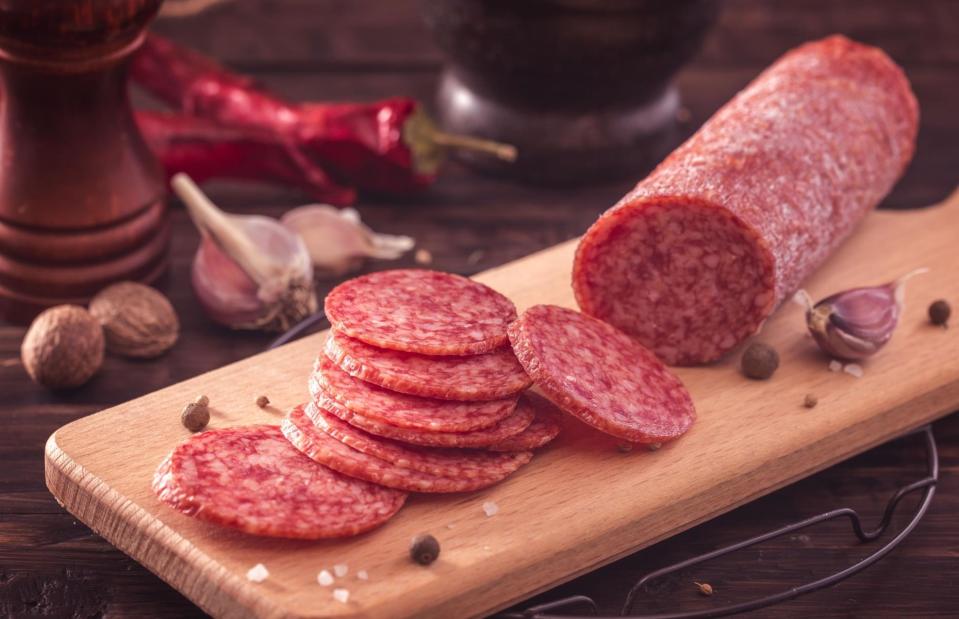
yingko/Shutterstock
Salami isn’t a single type of sausage but a whole family of Italian dried raw meat-slicing sausages. Usually unsmoked, salamis can be made from pork, beef or vitellone (young beef, similar to veal) and are pink in appearance, flecked with white fat. Regional variations include mild Milanese, flavoured with garlic, and spicy Sardinian sardo with red pepper. Salamis are typically eaten simply with bread, cheese and pickles.
4. Bratwurst, Germany

Natalia Kaiser/Shutterstock
Bratwurst is German grilling or frying sausage made from pork, beef or veal, first made in Nuremberg in the early 1300s. Varieties range from the long, thick and coarse Fränkische bratwurst, flavoured with marjoram, to the short, stubby and spicy rote würst from the Swabian region of southern Germany – made with ground beef and pork belly with flavours including white pepper, garlic, mace, coriander and ginger. Bratwurst are served simply with bread or potatoes and, often, sauerkraut.
3. 'Nduja, Italy
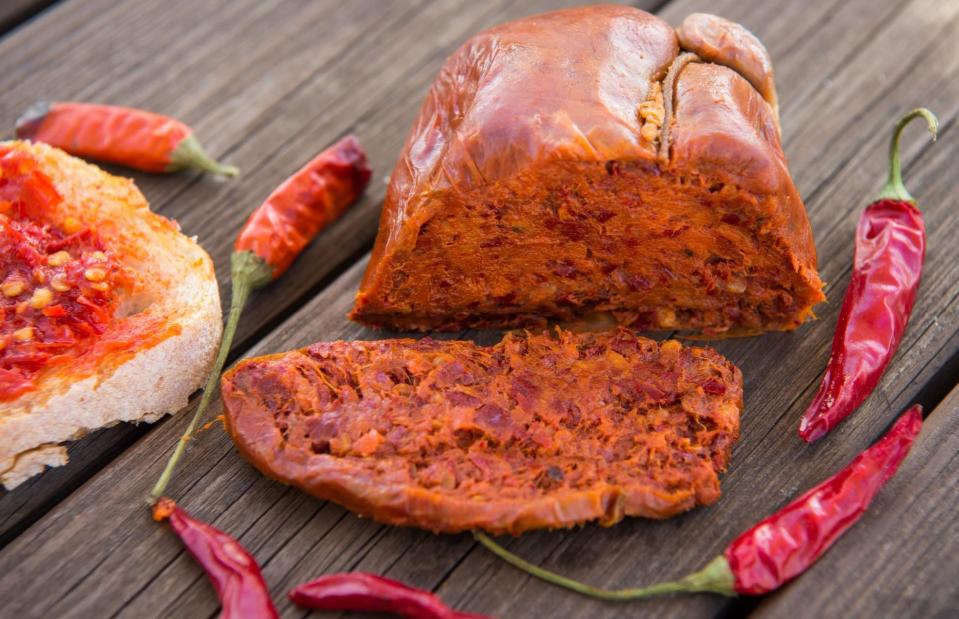
FVPhotography/Shutterstock
Originating from Calabria in southern Italy, this spiced, soft and spreadable fermented sausage is made from pigs' offal, ground with fatty cuts of pork and fiery Calabrian chilli and salt. Originally a peasant dish, the hot and slightly sour sausage, which is sometimes also smoked, is often eaten simply spread on bread. Since the mid-2010s, 'nduja has become a favourite ingredient of chefs and home cooks worldwide and might appear on pizzas, in pasta sauces or even to flavour chicken wings.
2. Chorizo, Spain
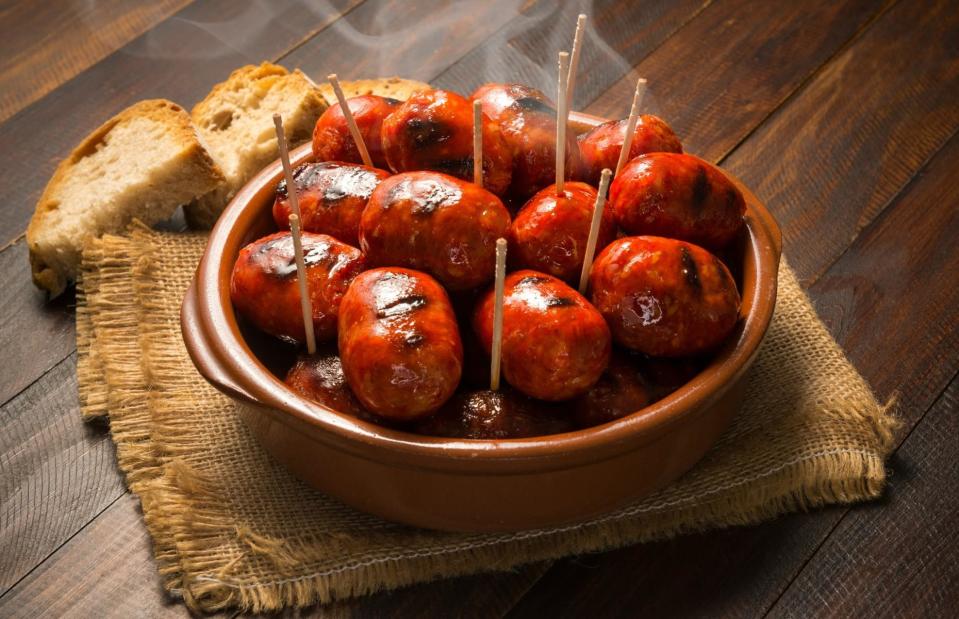
Studioimagen73/Shutterstock
Smoked paprika lends this Spanish pork sausage its ruddy hue and beguiling, distinct spicy flavour. Chorizo can be hot (picante) or sweet (dulce) and comes as a firmly textured dried and cured sausage ring, ready for slicing and eating, or as smaller fresh sausage links, ready to cook. Fresh chorizo can be cooked in cider or red wine and served as a tapa, while the dried and cured sausage can be served numerous ways including in a classic Spanish potato tortilla.
1. Frankfurter, Germany

WS-Studio/Shutterstock
As hinted by the name, Frankfurters were first made in the mid-17th century in the central German city of Frankfurt. The cold smoked sausage gets its soft texture from a blend of lean pork and bacon fat, seasoned with coriander, garlic and onion, and its pink colour from saltpetre. In Germany, the sausages are typically eaten with bread and mustard or potato salad, but have become world famous as the sausage in a hot dog.


